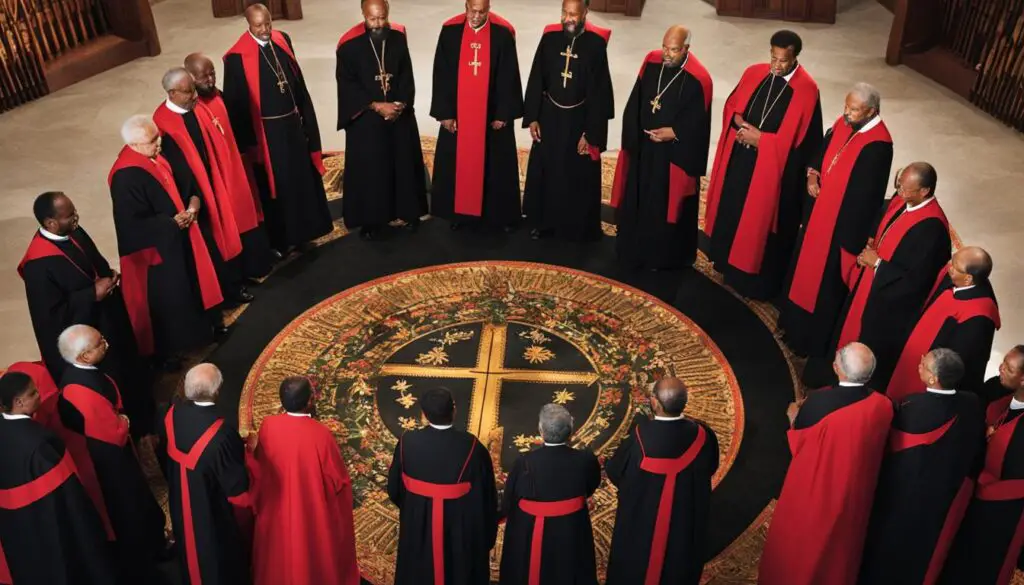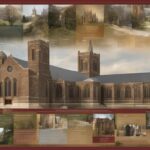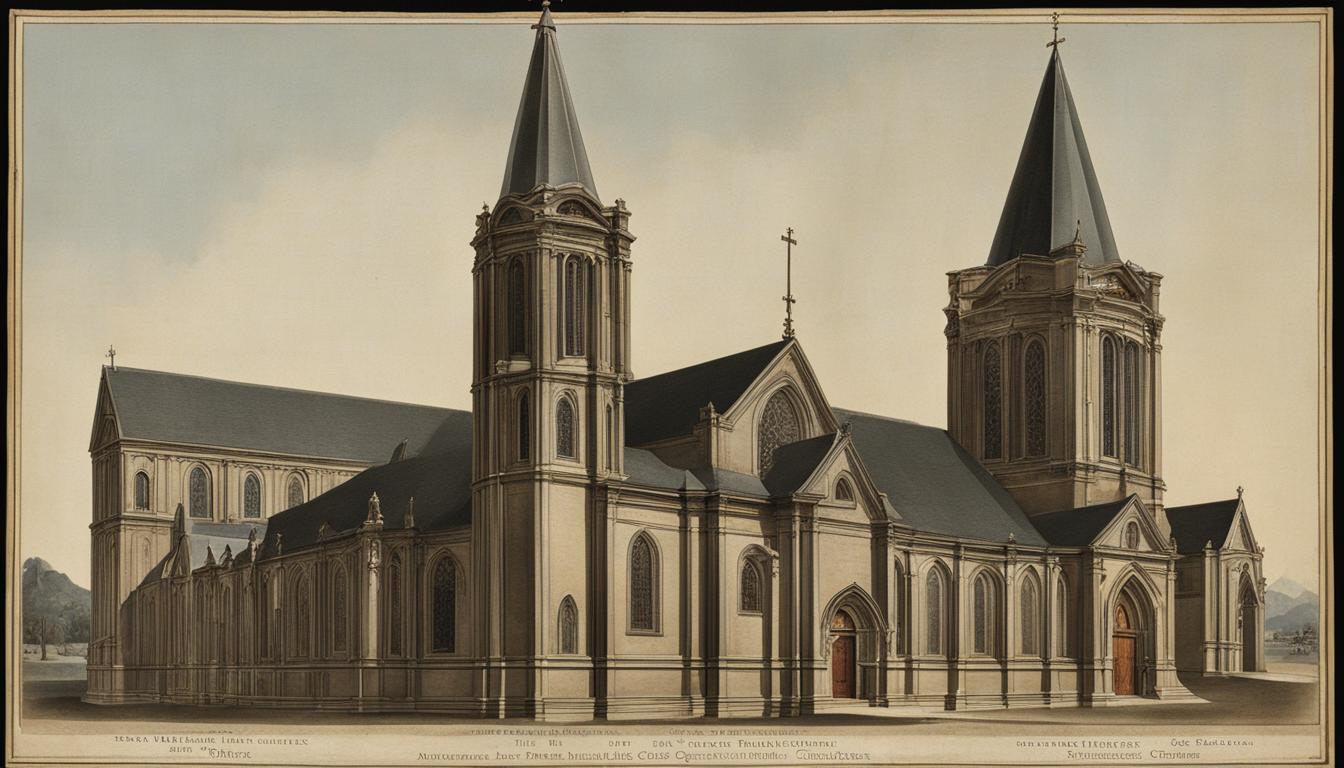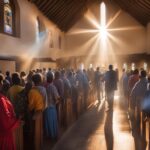Spiritual growth is at the heart of the church’s purpose. It is a journey that invites individuals to deepen their relationship with God and cultivate a vibrant faith. Through the church’s guidance, resources, and support, believers can embark on a transformative path of spiritual development.
Throughout history, the church has played a significant role in shaping societies, offering solace, and providing a framework for spiritual growth. Its origins can be traced back to the time of Jesus Christ, where the belief in Him as the Son of God and the savior of humanity laid the foundation for the church’s establishment.
Central to the church’s teachings are its beliefs and doctrines. While these can vary among different denominations and sects, they often encompass core principles such as the belief in the Holy Trinity, the divinity of Jesus Christ, and the authority of Scripture. These beliefs serve as guiding lights, illuminating the path of spiritual growth.
Sacraments and rituals are integral parts of the church’s worship practices. Baptism and communion, for example, symbolize spiritual cleansing and the commemoration of Jesus’ sacrifice. Other rituals, such as prayer, confession, and anointing of the sick, provide opportunities for believers to connect with God and seek His grace.
The church is led by dedicated clergy, including pastors, priests, and bishops, who shepherd the congregation on their spiritual journey. These leaders deliver sermons, administer sacraments, and provide pastoral care, nurturing the growth and well-being of the church community.
Worship is a central aspect of the church’s purpose, fostering a deep connection with the divine. It often encompasses singing hymns, praying, reading Scripture, and listening to sermons. Whether through traditional liturgical practices or contemporary expressions, worship allows believers to express their love and devotion to God.
The church recognizes certain sacred texts that inspire and inform its teachings. Foremost among these is the Bible, considered the inspired word of God. Different denominations may include additional sacred texts or theological interpretations, which enrich the understanding of faith and provide spiritual nourishment.
Within the broader church, various denominations and sects exist, each with its unique beliefs, practices, and organizational structures. These divisions may arise from theological differences or historical developments. However, despite these distinctions, the pursuit of spiritual growth and the spreading of love and redemption remain common threads.
Community and outreach are integral to the church’s purpose. Believers come together as a community, providing support, care, and fellowship. Additionally, the church actively engages in outreach efforts, seeking to extend love and assistance to those in need, embodying the values of compassion and justice.
Architectural and artistic features of the church evoke a sense of awe and reverence. Stained glass windows, ornate sculptures, and majestic bell towers create an atmosphere that inspires worship and contemplation. These elements reflect the beauty and depth of the spiritual journey.
Yet, the church also faces contemporary issues and challenges. Adapting to cultural shifts, addressing social justice concerns, navigating political tensions, and reconciling faith with the developments in science are some of the challenges that require discernment and engagement. The church strives to be a relevant and transformative presence in an ever-changing world.
Key Takeaways:
- Spiritual growth is a central aspect of the church’s purpose.
- The church’s beliefs and doctrines guide its teachings and practices.
- Sacraments and rituals play an important role in the church’s worship.
- Clergy provide leadership and pastoral care for the church community.
- Worship practices vary but aim to foster a deeper connection with God.
History and Origins of the Church
The church has a rich history that spans over two thousand years. Its origins can be traced back to the time of Jesus Christ, who established the foundation of the church with His teachings and disciples. It was founded on the belief in Jesus as the Son of God and the savior of humanity, and His death and resurrection form the core of Christian faith.
Throughout history, the church has played a significant role in shaping societies and cultures. It has been a guiding force, spreading the message of love, compassion, and redemption. From the early Christian communities to the global presence it holds today, the church has evolved and adapted to changing times, while maintaining its core principles.
The roots of the church can be seen in the Acts of the Apostles, which describes the early gatherings of believers and the formation of Christian communities. The early church faced persecution, yet it persevered, and its message continued to spread across continents.
| Key Events in Church History | Description |
|---|---|
| The Edict of Milan (313 AD) | This decree by the Roman Emperor Constantine ended the persecution of Christians and allowed for the expansion and recognition of Christianity. |
| The Council of Nicaea (325 AD) | The council addressed theological disputes and declared the divinity of Jesus Christ, leading to the formation of the Nicene Creed. |
| The Great Schism (1054 AD) | The division between the Roman Catholic Church and the Eastern Orthodox Church, marking a significant split in Christian history. |
| The Protestant Reformation (16th Century) | A religious movement led by Martin Luther and other reformers that challenged the practices and authority of the Catholic Church, ultimately leading to the establishment of various Protestant denominations. |

Quotes on Church History
“The church is not a gallery for the better exhibition of eminent Christians, but a school for the education of imperfect ones.” – Henry Ward Beecher
“The Church is a hospital for sinners, not a museum for saints.” – Abigail Van Buren
The rich history of the church serves as a reminder of its enduring impact on the world. It has weathered challenges, adapted to cultural shifts, and continues to provide spiritual guidance and support to millions of people globally. By understanding the history and origins of the church, we can gain deeper insight into its mission and purpose.
Beliefs and Doctrines of the Church
The church is founded on a set of beliefs and doctrines that serve as the guiding principles for its teachings and practices. While these beliefs can vary among different denominations and sects, there are core principles that are commonly shared across the Christian faith.
“So then, just as you received Christ Jesus as Lord, continue to live your lives in him, rooted and built up in him, strengthened in the faith as you were taught, and overflowing with thankfulness.”
| Beliefs | Description |
|---|---|
| Belief in the Holy Trinity | The church believes in the existence of one God who exists in three persons: God the Father, God the Son (Jesus Christ), and God the Holy Spirit. |
| Divinity of Jesus Christ | The church believes that Jesus Christ is the Son of God and the savior of humanity. His death and resurrection offer salvation and redemption to all who believe in him. |
| Authority of Scripture | The church recognizes the Bible as the inspired word of God. It is seen as the ultimate authority in matters of faith, morality, and spiritual guidance. |
| Salvation by Grace | The church believes that salvation is a gift from God, given by His grace. It is received through faith in Jesus Christ and cannot be earned through good works alone. |
| Resurrection and Second Coming | The church believes in the resurrection of Jesus Christ and the hope of his second coming. It teaches that believers will be raised to eternal life and share in the kingdom of God. |
These beliefs shape the church’s understanding of God, humanity, and the purpose of life. They provide a foundation for worship, teaching, and living out the Christian faith.

Embracing the Teachings
By embracing the beliefs and doctrines of the church, individuals find a framework for understanding and deepening their relationship with God. These beliefs provide a lens through which to interpret Scripture, navigate life’s challenges, and find meaning and purpose in the world.
Through the teachings of the church, believers are encouraged to live lives marked by love, compassion, and service to others. These beliefs also help shape the church’s mission of spreading the message of hope, forgiveness, and reconciliation to all people.
The church invites individuals to explore these beliefs, engage in thoughtful discussion, and seek a personal connection with God through the teachings of Jesus Christ.
Sacraments and Rituals in the Church
Sacraments and rituals play a pivotal role in the worship practices of the church. These sacred ceremonies and symbolic acts hold deep significance for believers, fostering spiritual growth and fostering a deeper connection with God.
The two most common sacraments in the church are baptism and communion. Baptism signifies a new beginning, a spiritual rebirth, and a cleansing of sins. It is typically performed through the pouring, sprinkling, or immersion of water, symbolizing purification and the entrance into the Christian faith.
Communion, also known as the Eucharist, is a ritual that commemorates the Last Supper of Jesus Christ with his disciples. During this sacrament, believers partake in bread and wine, which symbolize the body and blood of Jesus. Through communion, Christians remember the sacrifice of Jesus and reaffirm their faith in Him.
In addition to these primary sacraments, the church also engages in other rituals to deepen spiritual connection and seek divine guidance. Prayer, an essential aspect of the Christian faith, allows believers to communicate with God, express gratitude, and seek guidance. Confession is another ritual where individuals confess their sins to a priest, receiving absolution and experiencing spiritual healing.
The anointing of the sick, also known as the sacrament of the anointing of the sick or extreme unction, is a ritual that provides spiritual strength and healing to individuals who are seriously ill or nearing the end of their lives. Through the anointing with oil and prayer, believers find comfort and the hope of physical, emotional, and spiritual restoration.
| Sacraments | Meaning |
|---|---|
| Baptism | Symbolizes spiritual rebirth and cleansing of sins. |
| Communion | Commemorates the Last Supper of Jesus Christ and reaffirms faith in Him. |
| Prayer | Allows believers to communicate with God, express gratitude, and seek guidance. |
| Confession | Enables individuals to confess their sins and receive spiritual healing through absolution. |
| Anointing of the Sick | Provides spiritual strength and healing to the seriously ill or those nearing the end of their lives. |
The sacraments and rituals in the church serve as powerful reminders of God’s presence, grace, and love in the lives of believers. They create a sacred space for reflection, introspection, and spiritual transformation, nurturing the faith journey of individuals within the church community.

Leadership and Clergy in the Church
Church leadership plays a crucial role in guiding and nurturing the faith community. The clergy, consisting of pastors, priests, bishops, and ordained individuals, are entrusted with the responsibility of shepherding the congregation and ensuring the spiritual well-being of the church.
These dedicated leaders are called to serve as spiritual mentors and provide guidance to the members of the church. Through their sermons, teachings, and pastoral care, they offer support, encouragement, and insight to help individuals on their spiritual journey.
One of the primary roles of the clergy is to deliver sermons that inspire, educate, and challenge the congregation. These sermons are often centered around biblical teachings and aim to help individuals apply them to their daily lives. Through their words, clergy members help the church community connect with God, deepen their faith, and find meaning in the challenges of life.
Along with preaching, the clergy also administer sacraments, such as baptism and communion, which are significant rituals in the church. By performing these sacraments, they enable believers to experience spiritual transformation and connect with the divine presence.
Additionally, clergy members provide pastoral care, offering emotional support, counseling, and prayer for those facing difficulties or seeking guidance. They are there to provide comfort and solace during times of grief, illness, or personal crises.
To carry out their responsibilities effectively, clergy often undergo specialized education and training. They study theology, pastoral care, and church leadership to acquire the knowledge and skills necessary for guiding and serving the church community. This equips them to provide theological and biblical insights, navigate complex issues, and address the spiritual needs of the congregation.
“The role of the clergy is not just a profession; it is a calling. They are called to lead, teach, and shepherd God’s flock with love and compassion.”
Leadership Roles in the Church
| Leadership Role | Responsibilities |
|---|---|
| Pastor | Overseeing the overall spiritual well-being of the congregation, preaching, providing pastoral care, and leading the church community. |
| Priest | Leading worship services, administering sacraments, providing spiritual guidance and pastoral care. |
| Bishop | Overseeing multiple churches within a specific geographic region, ordaining clergy, teaching, and providing leadership and guidance. |
| Deacon | Assisting in various ministries, supporting the clergy, and serving the needs of the church community and the wider society. |
Through their leadership and dedication, the clergy embody the principles of service, devotion, and spiritual guidance. They play a vital role in fostering unity, growth, and the flourishing of the church community.

Worship Practices in the Church
Worship is at the heart of the church’s purpose, with each denomination offering its unique approach to fostering spiritual connection and reverence. While practices may have variations, certain elements remain fundamental in worship.
- Singing Hymns: Church worship often involves congregational singing of hymns, showcasing the power of music in expressing collective praise, gratitude, and devotion to God. Hymns bring together the congregation, inspiring unity and deepening faith.
- Praying: Prayer is a vital aspect of worship, allowing individuals to communicate with God, seek guidance, express gratitude, and offer intercessions. Collectively praying as a congregation amplifies the sense of community and connection with the divine.
- Reading Scripture: The Bible holds a central place in worship, serving as a source of guidance, spiritual nourishment, and inspiration. Reading Scripture during worship provides individuals with a deeper understanding of God’s word and offers insights for daily living.
- Listening to Sermons: A sermon is a time for pastors and preachers to share messages derived from Scripture, providing spiritual teachings, encouragement, and guidance for personal growth. Sermons offer opportunities for reflection, contemplation, and application of biblical principles.
While these elements form the core of worship practices, different denominations may incorporate additional forms of worship into their services. Some churches follow structured liturgical rituals, embracing a sense of sacred tradition, while others adopt contemporary approaches, incorporating modern music and interactive elements into worship.
In essence, the emphasis is on creating an atmosphere that cultivates a deep connection with God, fosters spiritual growth, and invites individuals to engage actively in their faith journey.
“Worship is not about performance; it’s about bringing an offering of your heart to the One who is worthy. It’s a sacred space where you can encounter the presence of God and experience His transformative power.”
The Power of Worship
Worship transcends the physical act of congregational gathering. It is a transformative experience that enables individuals to encounter the divine, find solace in times of distress, and draw strength and inspiration for daily life. When approached with sincerity, worship has the potential to ignite a deep sense of belonging, purpose, and spiritual connection.

Sacred Texts of the Church
The church places great significance on certain texts that are considered sacred. At the core of these sacred texts is the Bible, which is widely recognized as the inspired word of God. Within the Bible, different denominations may have additional books or interpretations that guide their beliefs and practices.
The Bible, consisting of the Old and New Testaments, serves as the foundation for Christian teachings and is revered as a divine revelation. It contains historical accounts, moral teachings, prophetic messages, and wisdom literature that offer guidance for spiritual growth and understanding.
Scripture plays a crucial role in the life of the church. It is used for teaching and preaching, providing spiritual nourishment and guidance to believers. The Bible is often read publicly during worship services, and its verses are studied and meditated upon for personal reflection and growth in faith.
It is important to note that different denominations may have variations in the canon of sacred texts, with additional books or slightly differing interpretations of existing ones. These differences may reflect historical, theological, or cultural influences.
Other Sacred Texts and Interpretations
In addition to the Bible, some denominations also recognize other texts as sacred. For example, Catholicism acknowledges the authority of sacred tradition and the teachings of the Magisterium alongside the Bible. Similarly, Eastern Orthodox Christianity places significance on the teachings of the early Church fathers and holds the Septuagint, a Greek translation of the Old Testament, in high regard.
“The Word of God is alive and active. Sharper than any double-edged sword, it penetrates even to dividing soul and spirit, joints and marrow; it judges the thoughts and attitudes of the heart.” – Hebrews 4:12
The study and interpretation of sacred texts are undertaken by theologians and scholars who seek to unravel their deep meaning and relevance to contemporary life. These texts serve as a source of spiritual wisdom, moral guidance, and inspiration for believers, shaping their understanding of God’s will and fostering a deeper connection with the divine.
| Denomination | Sacred Texts |
|---|---|
| Catholicism | Bible, Sacred Tradition, Magisterial Teachings |
| Protestantism | Bible |
| Eastern Orthodoxy | Bible, Septuagint, Church Fathers’ Teachings |
| Other Denominations | Varies, additional texts may be recognized |
Denominations and Sects in the Church
The church is a diverse and vibrant institution, encompassing various denominations and sects that reflect the multifaceted nature of Christian faith. These diverse groups have unique beliefs, practices, and organizational structures, contributing to the rich tapestry of Christianity. Let’s explore some well-known denominations:
Catholicism
Catholicism is one of the oldest and largest Christian denominations, with its roots tracing back to the time of Jesus Christ and the apostles. The Catholic Church recognizes the authority of the Pope and upholds the sacraments as essential elements of its faith.
Protestantism
Protestantism emerged during the Reformation in the 16th century as a response to perceived abuses and corruption within the Catholic Church. Protestant denominations, such as Lutheranism, Calvinism, and Anglicanism, emphasize salvation by faith alone, scripture as the ultimate authority, and the priesthood of all believers.
Orthodox Christianity
Orthodox Christianity encompasses various Eastern Orthodox churches, such as the Greek Orthodox, Russian Orthodox, and Coptic Orthodox churches. These churches trace their origins back to the early days of Christianity and hold a distinct liturgical and spiritual tradition.
Methodism
Methodism is a Protestant denomination that originated in the 18th century as a movement within the Anglican Church, led by John Wesley. Methodists emphasize personal piety, social justice, and the importance of small group meetings, known as “class meetings,” for spiritual accountability and growth.
Baptist
Baptist churches are characterized by their belief in adult baptism through immersion and the autonomy of the local church. Baptists uphold individual soul liberty, meaning that each believer has the freedom to interpret scripture and discern God’s will independently.
Presbyterianism
Presbyterian denominations, such as the Presbyterian Church (USA) and the Church of Scotland, follow a system of church governance led by elected elders. They emphasize the sovereignty of God, the authority of scripture, and the importance of a disciplined Christian life.
Lutheranism
Lutheranism, founded by Martin Luther in the 16th century, upholds the teachings of the Protestant Reformation. Lutherans emphasize salvation by grace through faith and assert the doctrine of justification, which holds that individuals are made right with God through faith in Jesus Christ.
Other Denominations
These are just a few examples of the many denominations within the broader Christian church. Other notable denominations include the Anglican Communion, Pentecostalism, the Seventh-day Adventist Church, and the Mormon Church, each with its own distinctive beliefs and practices.
It’s important to remember that denominations and sects within the church should be seen as different expressions of the same Christian faith, rather than sources of division. Each denomination or sect offers unique perspectives and interpretations of the Christian message while sharing a common foundation in Jesus Christ.
Now let’s take a look at a table comparing some key characteristics of these major Christian denominations:
| Denomination | Beliefs | Leadership | Worship Style |
|---|---|---|---|
| Catholicism | Belief in the Pope’s authority and sacraments | Pope, Bishops, Priests, Deacons | Liturgical |
| Protestantism | Emphasis on faith, scripture, and the priesthood of all believers | Varies (Pastors, Ministers, Elders) | Varies (from traditional to contemporary) |
| Orthodox Christianity | Strong emphasis on liturgy, icons, and saints | Patriarchs, Bishops, Priests | Liturgical |
| Methodism | Emphasis on personal piety and social justice | Ordained Ministers, Lay Leaders | Varies (traditional and contemporary) |
| Baptist | Believer’s baptism by immersion and local church autonomy | Pastors, Deacons, Lay Leaders | Varies (from traditional to contemporary) |
| Presbyterianism | Emphasis on God’s sovereignty and biblical authority | Teaching Elders (Ministers), Ruling Elders | Varies (from traditional to blended) |
| Lutheranism | Belief in salvation by grace through faith alone | Pastors, Bishops | Liturgical |
Community and Outreach in the Church
In addition to being a place of worship, the church serves as a vibrant community of believers. The Church Community provides a supportive environment that fosters spiritual growth and encourages individuals to live out their faith in practical ways. Through various outreach initiatives, the church extends its love and assistance to those in need, both within the congregation and in the wider world.
Church Outreach is an essential expression of compassion and service. It involves actively seeking opportunities to make a positive difference in the lives of others, demonstrating God’s love through meaningful actions. Engaging in outreach efforts allows the church to live out its mission of love, compassion, and social justice.
- Charity Work: Donating resources, time, and expertise to support charitable organizations and initiatives that address societal needs such as poverty alleviation, healthcare, education, and disaster relief.
- Mission Trips: Traveling to different locations, both domestically and internationally, to serve communities in need, share the message of hope, and provide practical assistance.
- Social Justice Advocacy: Standing up for the rights and well-being of marginalized individuals and groups, addressing issues such as systemic inequality, human trafficking, racial injustice, and environmental stewardship.
By actively engaging in community and outreach efforts, the church becomes a beacon of hope, embodying Christ’s teachings of love, mercy, and compassion. Through these initiatives, the church is able to positively impact individuals’ lives, demonstrating the transformative power of faith in action.
“The church is not a building but a community of believers, united in love, compassion, and service.”
Examples of Church Outreach Initiatives
| Initiative | Description |
|---|---|
| Food Pantry | Providing food and essential supplies to individuals and families facing food insecurity, offering support and hope in times of need. |
| Homeless Shelter | Offering a safe haven and resources for homeless individuals, providing temporary shelter, meals, and assistance in transitioning to stable housing. |
| Education Programs | Organizing tutoring, mentoring, and scholarship programs to empower individuals with the necessary knowledge and skills for a brighter future. |
| Community Clean-up | Engaging in local environmental initiatives such as park clean-ups, tree planting, and recycling campaigns to promote a cleaner and healthier community. |
| Prison Ministry | Providing spiritual guidance, support, and rehabilitation programs for incarcerated individuals, aiming to bring healing, hope, and transformation. |
Architectural and Artistic Features of the Church
Churches are not only places of worship but also breathtaking showcases of architectural and artistic brilliance. The designs and features found in these sacred spaces are meticulously crafted to evoke a sense of reverence and awe in those who enter.
One of the most notable architectural elements in churches is the stained glass windows. These stunning works of art depict biblical scenes, saints, and religious symbols, allowing natural light to cascade through vibrant hues and illuminate the space with a heavenly glow. Each window tells a story, inviting worshippers to reflect and find inspiration in the narratives they depict.
The sculptures found within churches are another testament to the exquisite craftsmanship and devotion to faith. From larger-than-life statues of religious figures and saints to intricately carved reliefs and friezes, these sculptures serve as a visual representation of the church’s beliefs and teachings. They offer a tangible connection to the divine, inspiring worshippers to contemplate and deepen their spirituality.
Elaborate bell towers, also known as campaniles, are a prominent feature in many churches. These towering structures not only house bells that chime melodiously throughout the day but also serve as an architectural symbol of the church’s presence in the community. The bell towers stand tall, reaching towards the heavens, reminding believers of their spiritual calling and the importance of their faith.
H3: Symbolism in Church Architecture
The architectural features of a church often incorporate symbolic elements that hold deep meaning within the faith. For example, the shape of a church building itself resembles the cross, with the nave representing the vertical beam and the transepts forming the horizontal arms. This design serves as a constant reminder of the sacrifice and redemption brought about by Jesus Christ.
The altar, positioned at the center of the church, is the focal point of worship. Its elevated position signifies the sacredness of the space and symbolizes the presence of Christ during the Eucharistic celebration. The altar is often adorned with ornate decorations and a crucifix, further emphasizing its significance within the church’s worship practices.
| Architectural Features | Artistic Elements |
|---|---|
| Stained glass windows | Sculptures |
| Bell towers | Symbolism |
| Altars |
Contemporary Issues and Challenges for the Church
The church today faces numerous challenges and issues in the rapidly changing modern world. Adapting to cultural shifts, addressing social justice concerns, navigating political tensions, and engaging with issues of faith and science are just a few of the obstacles that churches must confront. In order to remain relevant and impactful, the church must continually evaluate these challenges and develop strategies to effectively respond.
One of the key challenges churches encounter is the need to adapt to cultural shifts. Society is constantly evolving, and churches must navigate the changing values, attitudes, and beliefs of their congregations. This includes embracing diversity and inclusivity, promoting equality, and creating an environment that is welcoming and relevant to people of all backgrounds.
Social justice concerns also present significant challenges for the church. Issues such as poverty, inequality, racism, and environmental degradation require churches to actively engage in advocacy, awareness raising, and practical initiatives. The church has a responsibility to support and uplift marginalized communities and work towards creating a more just and equitable society.
Navigating political tensions is another challenge faced by the church. Political polarization and divisive issues can create conflicts within congregations and put strain on the church’s unity and mission. The church must strive to promote understanding, respect, and dialogue, while firmly upholding its core principles and values.
Engaging with the intersection of faith and science is an ongoing challenge for the church in the modern world. As scientific advancements continue to shape our understanding of the world, the church must find ways to reconcile scientific discoveries with religious beliefs. This requires open dialogue, critical thinking, and a willingness to embrace new knowledge while remaining grounded in faith.
“The true measure of any society can be found in how it treats its most vulnerable members.”
Despite these challenges, the church has an opportunity to make a positive impact and inspire change. By actively addressing these contemporary issues with compassion, education, and action, the church can become a powerful force for social transformation and a source of hope and guidance for individuals and communities.
| Contemporary Issues | Challenges |
|---|---|
| Adapting to cultural shifts | Embracing diversity and inclusivity |
| Addressing social justice concerns | Promoting equality and justice |
| Navigating political tensions | Promoting understanding and unity |
| Engaging with issues of faith and science | Reconciling scientific discoveries with religious beliefs |
By acknowledging and actively confronting these challenges, the church can continue to evolve and remain relevant in an ever-changing world, fulfilling its mission of spreading love, compassion, and hope.
Conclusion
The church is founded on a multi-faceted purpose, encompassing spiritual growth, community, outreach, and worship. Understanding the history, beliefs, and practices of the church provides individuals with a meaningful and fulfilling journey of faith. As the church continues to adapt and respond to contemporary issues and challenges, its mission remains steadfast – to spread the message of love and redemption.
Spiritual growth is a key aspect of the church’s purpose. Through guidance, resources, and support, the church facilitates a deeper relationship with God, allowing individuals to nurture and develop their faith.
Community and outreach are integral to the church’s mission. By engaging in charity work, mission trips, and social justice advocacy, the church extends love and assistance to those in need, reflecting the teachings of Jesus Christ.
Worship practices, including singing hymns, praying, reading Scripture, and listening to sermons, foster a sense of unity and reverence. These practices can vary among denominations, but they all serve to connect believers to their faith and to one another.
Throughout its rich history, the church has faced numerous challenges and contemporary issues. Adapting to cultural shifts, addressing social justice concerns, and engaging with matters of faith and science are vital aspects of the church’s ongoing mission.
As diverse denominations and sects exist within the church, each with its own unique beliefs and practices, unity is found in the shared vision of spreading the message of love and redemption to all. The church’s architectural and artistic features further enhance the worship experience, reflecting the beauty of faith through stained glass windows, sculptures, and sacred spaces.
In conclusion, the church’s ultimate purpose is to provide individuals with a spiritual home, a community of believers, and a platform for reaching out to the world. By embracing its history, beliefs, and practices, the church creates a path for growth, connection, and service, fulfilling its mission and vision for a better future.
FAQ
What is the purpose of the church?
The purpose of the church is multifaceted, encompassing spiritual growth, community, outreach, and worship.
How does the church facilitate spiritual growth?
The church helps individuals develop a deeper relationship with God and grow in their faith through resources, guidance, and support.
What is the history and origin of the church?
The church has a rich history that dates back to the time of Jesus Christ and has played a vital role in shaping societies and spreading the message of love and redemption.
What are the beliefs and doctrines of the church?
The church has a set of beliefs and doctrines that guide its teachings and practices, which can vary among different denominations and sects.
What are the sacraments and rituals in the church?
The church practices sacraments such as baptism and communion, which symbolize spiritual cleansing and the commemoration of Jesus’ sacrifice. Other rituals may include prayer, confession, and anointing of the sick.
Who leads the church?
The church is led by clergy, including pastors, priests, bishops, and other ordained individuals. These leaders are responsible for guiding the church, delivering sermons, administering sacraments, and providing pastoral care to the congregation.
How does the church worship?
Worship in the church typically involves elements such as singing hymns, praying, reading Scripture, and listening to sermons. Practices can vary among denominations, incorporating liturgical rituals or contemporary music.
What texts are considered sacred in the church?
The church holds certain texts as sacred, including the Bible, which is considered the inspired word of God. Different denominations may have additional sacred texts or interpretations that guide their beliefs and practices.
What are the denominations and sects within the church?
The church is comprised of various denominations and sects, each with its own distinct beliefs, practices, and organizational structures. Examples include Catholicism, Protestantism, and Orthodox Christianity.
How does the church engage with the community and outreach?
The church serves as a community of believers who support and care for one another. It also engages in outreach efforts to extend love and assistance to those in need through activities such as charity work, mission trips, and social justice advocacy.
What are the architectural and artistic features of the church?
Churches often feature distinct architectural styles and artistic elements, such as stained glass windows, ornate sculptures, and elaborate bell towers. These features contribute to the overall aesthetic and sense of reverence within the church.
What are the contemporary issues and challenges for the church?
The church faces various contemporary issues and challenges in the modern world, including adapting to cultural shifts, addressing social justice concerns, navigating political tensions, and engaging with issues of faith and science.
What is the conclusion about the church’s purpose?
By understanding the history, beliefs, and practices of the church, individuals can find meaning, fulfillment, and a sense of purpose in their journey of faith. The church continues to adapt and respond to contemporary issues and challenges as it seeks to fulfill its mission of spreading the message of love and redemption.
















